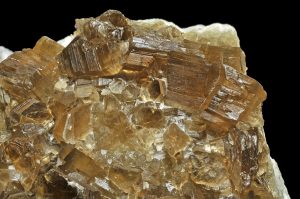Phlogopite
Phlogopite is a rarer member of the Mica Group of minerals and is not well known even by mineral collectors. The chemical formula of Phlogopite is KMg3AlSi3O10(OH, F)2 (Potassium Magnesium Aluminum Silicate Hydroxide Fluoride) and its molecular weight is 419.25 gm. It has been mined however for its heat and electrical insulating properties which are considered superior to other Micas. Phlogopite has a specific gravity of 2.78 – 2.85 (g/cm3) and refractive index of 1.530 – 1.618 Biaxial ( – ) . The typical light brown color of Phlogopite is characteristic although it is difficult to distinguish brown Biotite from dark brown Phlogopite. The two are end members of a series that is dependent on the percentage of iron. Phlogopite is iron poor and Biotite is iron rich. The darker color and density increase with an increase in the iron content. Phlogopite, like other Micas, has a layered structure which produces its perfect cleavage. Phlogopite is rarely considered a valuable mineral specimen and is rarely available as a cabochon gem.
Distribution: Some localities for well-crystallized material include: in the USA, from Antwerp and Natural Bridge, Jefferson County, and Edwards and Pierrepont, St. Lawrence County, New York; from Franklin, Sussex County, New Jersey. In Canada, large crystals from the Lacey mine, Frontenac County, and in North and South Burgess Townships, Ontario; from near Perkin’s Mills, and elsewhere in Gatineau County, Quebec. In the Slyudyanka region, near Lake Baikal, Siberia, Russia. At Ødegården, near Feset, Norway. From Campolungo, near St. Gotthard, Ticino, Switzerland. In the Val di Fassa, Trentino-Alto Adige, and on Monte Braccio, Val Malenco, Lombardy, Italy. From Saharakara and Ampandrandava, Madagascar. At Anxiety Point, Nancy Sound, New Zealand.
| Chemical Formula: | KMg3AlSi3O10(OH, F)2 |
| Potassium Magnesium Aluminum Silicate Hydroxide Fluoride | |
| Molecular Weight: | 419.25 gm |
| Composition: | Potassium | 9.33 % | K | 11.23 % | K2O |
| Magnesium | 17.39 % | Mg | 28.84 % | MgO | |
| Aluminum | 6.44 % | Al | 12.16 % | Al2O3 | |
| Silicon | 20.10 % | Si | 42.99 % | SiO2 | |
| Hydrogen | 0.24 % | H | 2.15 % | H2O | |
| Oxygen | 41.98 % | O | |||
| Fluorine | 4.53 % | F | 4.53 % | F | |
| – % | F | -1.91 % | -O=F2 | ||
| 100.00 % | 100.00 % | = TOTAL OXIDE |
| Crystallography: | Monoclinic – Prismatic |
| Crystal Habit: | Crystals six-sided, thick tabular to prismatic, commonly tapered, to 10 m and 270 t. Also coarse-grained, platy, and as small scales. |
| Twinning: | Composition plane {001}, twin axis [310]. |
| Cleavage: | Perfect on {001} |
| Fracture: | Irregular/Uneven |
| Tenacity: | Tough; thin laminae flexible and elastic |
| Moh’s Hardness: | 2.0 – 3.0 |
| Density: | 2.78 – 2.85 (g/cm3) |
| Luminescence: | Fluorescent; straw yellow to lemon yellow under SW UV, weak blue-white to blue-gray under LW UV |
| Radioactivity: | Barely Detectable; GRapi = 133.53 (Gamma Ray American Petroleum Institute Units) |
| Color: | Brownish red, dark brown, yellowish brown, green, white; colorless, pale yellow, or green in thin section. |
| Transparency: | Transparent to Translucent |
| Luster: | Pearly to Submetallic on cleavages |
| Refractive Index: | 1.530 – 1.618 Biaxial ( – ) |
| Birefringence: | 0.028 – 0.045 |
| Dispersion: | Distinct; r < v |
| Pleochroism: | Visible; X = yellow; Y = Z = brownish red, green, yellow. |


